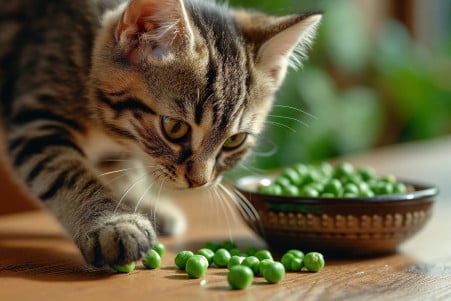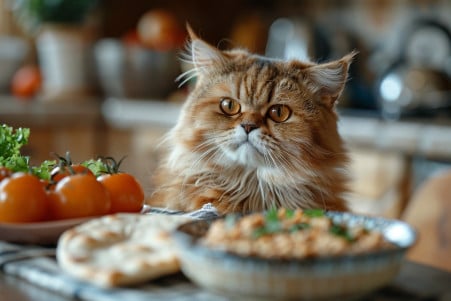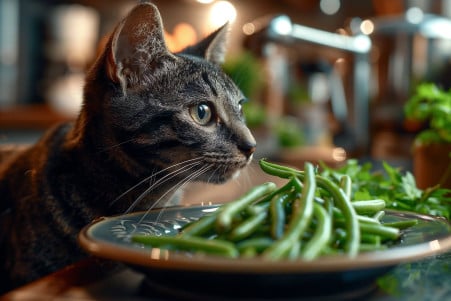Can Cats Eat Chickpeas? Moderation and Feline Nutrition Explained
14 March 2024 • Updated 12 March 2024

While chickpeas are a healthy snack for people, you may wonder if they are safe for your cat to eat. The short answer is that cats can eat chickpeas in moderation since they are not poisonous. However, since cats are obligate carnivores, chickpeas should not be a regular part of their diet.
Cats can have plain, cooked chickpeas as an occasional treat, but their high fiber content means that too many can lead to digestive upset.
In this deep dive into feline nutrition, we will review a range of research in veterinary science, animal nutrition, and domestic animal behavior to learn about the impact of feeding chickpeas to cats.
We will primarily focus on studies that have investigated cats’ protein needs, their digestive physiology, and their ability to digest plant-based proteins. By the end of this article, you will know where chickpeas stand in a cat’s diet and how to make sure that what you feed your pet is both healthy and safe.
Can cats eat chickpeas?
The Carnivorous Cravings: Why Cats Need Animal-Based Proteins
Cats’ nutritional requirements are based on their evolution as obligate carnivores. VCA Animal Hospitals describes obligate carnivores as animals that need to consume meat to be healthy because they require certain nutrients that are only found in animal tissue. Cats don’t have the enzymes necessary to digest plant material efficiently, so animal-based proteins are a necessary part of their diet.
Cats can’t make essential nutrients like taurine, certain essential fatty acids, and important vitamins such as vitamin A and niacin, so they have to get them from their diet, and that means mainly from animal-based proteins.
While Cornell University’s College of Veterinary Medicine notes that the protein content of a cat’s diet is important, not all proteins are created equal. For example, plant-based proteins like those found in chickpeas may not contain the full complement of amino acids that cats need, which can lead to nutritional deficiencies.
Although a study published by PMC notes that cats can digest plant proteins, the study also notes that the digestibility of the protein is important. Animal-based proteins are more digestible and provide the amino acid profile that cats need, while plant-based proteins like those found in chickpeas do not.
As a result, it’s important for cat owners to make sure their pets are getting plenty of animal-based proteins in their diets to ensure they stay healthy.
How Chickpeas Impact the Feline Gut
Cats have highly specialized digestive systems that have evolved to process animal proteins, which contain the essential nutrients that cats need as obligate carnivores. As a result, plant-based proteins like those found in chickpeas can be hard for cats to digest. While not toxic, chickpeas can cause digestive upset in cats.
The Merck Veterinary Manual notes that cats are prone to stomach and intestinal issues, including constipation and colitis. These issues can cause cats to have difficulty defecating and pass stools that contain mucus, which the high fiber content in chickpeas can make worse.
In addition, cats have a gut microbiome that’s not as well-equipped to ferment plant fibers as other animals, which can further complicate the difference between plant-based and animal-based proteins.
A study in PMC notes that the unique anatomy of cats means that they have to be treated differently in surgery, which shows that cats’ bodies are different from other animals in a number of ways. This includes how they digest food. As a result, chickpeas and other legumes should be added to a cat’s diet with care and with the help of a veterinarian to avoid digestive upset.
The Nutritional Balancing Act: Legumes in a Cat’s Diet
Legumes, such as chickpeas, lentils, and peas, have become increasingly common in pet food formulas due to their high protein and fiber content. As Oven-Baked Tradition explains, legumes contain 19–25% raw protein, which is much higher than grains, and they offer a good balance of soluble and insoluble fiber, which can help with digestion. That said, the situation is more complicated for cats.
The potential health problems for cats eating legumes are due to anti-nutrients, including lectins, which, as Dr. Tom Cameron explains in an article in the IVC Journal, can block the absorption of important nutrients, like taurine.
Moreover, the anti-nutrients may not be fully deactivated during pet food processing, which would mean they could still pose a risk. While there is evidence that legumes can be good for people, the research on their long-term use in cat diets is limited, which makes it hard to say for sure.
Opinions among experts about the use of legumes in commercial cat food are mixed. While some experts argue that legumes are a good source of nutrition, others warn against feeding legumes to cats on a regular basis because of potential digestive problems and the fact that cats are obligate carnivores, as explained by Catster.
When it comes to the health effects of chickpeas and other legumes on cats, it’s important to consider the nutritional value they offer in addition to the potential risks and always talk to a vet about what’s best for your cat.
Yummy and Healthy: The Best Healthy Treats for Cats
If you’re thinking about healthy treat options for your cat, it’s important to choose treats that meet their nutritional needs as obligate carnivores.
As mentioned on Catster, carrots can help cats by providing vitamin K, B6, potassium, fiber, lutein, and zeaxanthin, which can help with eye health and vision. Blueberries are another safe and helpful option, as they offer hydration, fiber, and antioxidants, which can help hydrate your cat, especially if they eat dry food.
For those who want to add some vegetables to their cat’s diet, squash is a good option because it’s high in dietary fiber, which can help reduce hairballs and gastrointestinal issues.
Peas, which are often found in dry cat food, are a good source of vitamins, minerals, and fiber, but they should not be used as a protein source. Spinach is high in essential vitamins and minerals and can be a good option, but it should be fed in small amounts and avoided for cats with urinary or kidney problems.
Make sure you introduce these foods in small amounts so you can watch for any negative reactions, and always make sure you’re using these treats as a supplement to a diet that’s primarily made up of animal proteins.
And most importantly, as Vet Help Direct suggests, make sure you talk to your vet before you make any changes to your cat’s diet to make sure you’re doing what’s best for your cat’s health.
Final Thoughts on Cat Nutrition and Chickpea Snacks
In wrapping up our discussion of chickpeas and cats, it’s clear that while chickpeas are not poisonous to cats, they are not the best snack for our obligate carnivore friends.
The most important nutritional points to remember are that chickpeas are high in protein and fiber, which can be helpful, but the importance of animal-based protein in a cat’s diet cannot be overstated. Cats need certain nutrients like taurine, vitamin B12, and vitamin D, all of which they get from animal sources very effectively.
As both the Litter-Robot Blog and Cat Bandit Blog point out, it’s important to introduce chickpeas to your cat’s diet carefully and with the help of a vet. The potential for digestive upset and the possibility of nutritional deficiencies mean that you should be careful. It’s also important to remember that you should always get a vet’s input before making any changes to your cat’s diet.
So, while a few chickpeas won’t hurt your cat, they should never be a substitute for a diet that’s based on animal protein. The best way to prioritize your cat’s health is to make sure that you’re feeding them in a way that’s in line with their natural dietary needs, which will help ensure their health and happiness in the long run.


